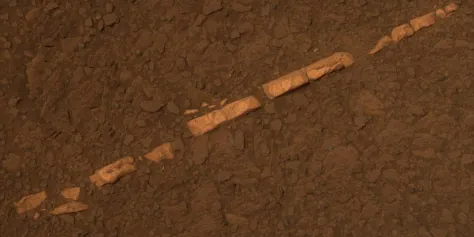
Opportunity's discovery – seen here in 'approximate true colour' – may shed new light on Mars's geological past
Credit:NASA/JPL-Caltech/Cornell/ASU
NASA’s Mars rover Opportunity has discovered a vein of calcium sulphate on the edge of the rim of crater Endeavour. The seam appears to have been deposited by water flowing through underground fractures in the Martian rock. This finding should help scientists develop a clearer picture of Mars’s wet geological history.
The vein of mineral in question – nicknamed ‘Homestake' – is just 1cm-2cm wide and 40cm-50cm long. Using Opportunity’s Panoramic Camera, Microscopic Imager and Alpha Particle X-Ray Spectrometer, scientists have determined that it is made up of calcium sulphate, probably in the form of gypsum (used on Earth to make plaster of Paris). It would have formed when flowing water dissolved calcium out of volcanic rocks; the calcium could then have reacted with sulphur in volcanic gases. This process is well-understood on Earth, but this is the first time it has been seen on Mars.
Analysis of the vein also suggests that it formed under less acidic conditions than those responsible for forming the calcium sulphate, magnesium and iron minerals already found on the Martian planes. “It could have formed in a different type of water environment, one more hospitable for a larger variety of living organisms,” said Opportunity science team member Benton Clark of the Space Science Institute in Boulder, Colorado.
The Opportunity rover continues to send back valuable data years after the end of its primary mission in 2004. It is currently heading towards a Sun-facing slope on the Endeavor crater rim, in order to keep its solar panels at a favourable angle during the oncoming Martian winter.
For technical information on how Opportunity acquired the above image, click here